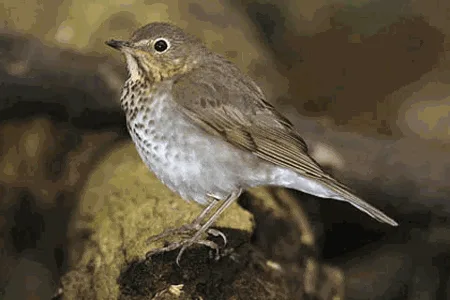
Swainsons Thrush
[order] PASSERIFORMES | [family] Turdidae | [latin] Catharus ustulatus | [UK] Swainsons Thrush | [FR] Grive a dos olive | [DE] Zwergdrossel | [ES] | [NL] Dwerglijster
Subspecies
| Genus | Species | subspecies | Breeding Range | Breeding Range 2 | Non Breeding Range |
| Catharus | ustulatus | NA | widespread | LA | |
| Catharus | ustulatus | appalachiensis | |||
| Catharus | ustulatus | incanus | |||
| Catharus | ustulatus | oedicus | |||
| Catharus | ustulatus | phillipsi | |||
| Catharus | ustulatus | swainsoni | |||
| Catharus | ustulatus | ustulatus |
Physical charateristics
Adults are brown on the upperparts. The underparts are white with brown on the flanks; the breast is lighter brown with darker spots. They have pink legs and a light brown eye ring. Birds in the east are more olive-brown on the upperparts; western birds are more reddish-brown. This bird’s song is a hurried series of flute-like tones spiralling upwards.
Listen to the sound of Swainsons Thrush
[audio:http://www.aviflevoland.nl/sounddb/S/Swainsons Thrush.mp3]
Copyright remark: Most sounds derived from xeno-canto
| wingspan min.: | 29 | cm | wingspan max.: | 31 | cm |
| size min.: | 16 | cm | size max.: | 18 | cm |
| incubation min.: | 12 | days | incubation max.: | 13 | days |
| fledging min.: | 10 | days | fledging max.: | 13 | days |
| broods: | 1 | eggs min.: | 3 | ||
| eggs max.: | 5 |
Range
North America : widespread
Habitat
The breeding habitat of Swainson’s Thrush is coniferous woods with dense undergrowth across Canada, Alaska and the northern United States, also deciduous wooded areas on the Pacific coast of North America.
Reproduction
Nest usually built in a small fir, spruce, hemlock, vine maple, alder, or willow, on a horizontal branch near the trunk. Built 1.2-2 meters above ground. It is a bulky, well-made cup of twigs, mosses, bark, grasses, rootlets, wet leaves; lined with lichens, plant fibers, skeletonized leaves, and sometimes animal hair. Often concealed with outer covering of live green moss. More elaborately and neatly constructed than those of other thrushes. The female builds the nest in about 4 days. Clutch size is 3-5, usually 4 eggs. Pale blue, evenly spotted with brown, generally more brown about the larger end. Oval with a smooth shell and very little gloss. Incubation by the female alone, lasts approximately 12-13 days. Incubation begins after the third egg is laid. Young are altricial. The young are fed by both parents, at first by regurgitation and by bringing them small insects. Gradually the insects become larger and some fruit may be substituted if insect prey is not as abundant. They are brooded by the female for the first few days. The nestling’s eyes open at 2-3 days, the feather plumes erupt from the sheaths at 7-10 days, and the young leave the nest at 10-12 days. Single brooded. Occasionally a host to parasitizing cowbirds.
Feeding habits
Mostly a ground feeder; also forages by gleaning from foliage and occasionally from branches as well as by hawking insects on the wing. Most frequently hunts from a low branch, hopping from perch to perch searching for prey on the ground or within low branches; swoops to pick up prey items in a similar fashion as the Veery. Young are fed insects and possibly some fruit.
Eats beetles of all kinds, weevils, ants, wild bees, wasps, caterpillars, spruce bud moths, mosquitoes, crane flies, treehoppers, cicadas, and also spiders, millipedes, snails, sowbugs, earthworms, domestic and wild cherries, blackberries, raspberries, seeds of twinberry, and elderberry. Becomes more frugivorous during late summer, fall, and winter.
Eats beetles of all kinds, weevils, ants, wild bees, wasps, caterpillars, spruce bud moths, mosquitoes, crane flies, treehoppers, cicadas, and also spiders, millipedes, snails, sowbugs, earthworms, domestic and wild cherries, blackberries, raspberries, seeds of twinberry, and elderberry. Becomes more frugivorous during late summer, fall, and winter.
Conservation
This species has an extremely large range, and hence does not approach the thresholds for Vulnerable under the range size criterion (Extent of Occurrence <20,000 km2 combined with a declining or fluctuating range size, habitat extent/quality, or population size and a small number of locations or severe fragmentation). Despite the fact that the population trend appears to be decreasing, the decline is not believed to be sufficiently rapid to approach the thresholds for Vulnerable under the population trend criterion (>30% decline over ten years or three generations). The population size is extremely large, and hence does not approach the thresholds for Vulnerable under the population size criterion (<10,000 mature individuals with a continuing decline estimated to be >10% in ten years or three generations, or with a specified population structure). For these reasons the species is evaluated as Least Concern.

Migration
These birds migrate to southern Mexico and as far south as Argentina. The coastal subspecies migrate down the Pacific coast of North America and winter from Mexico to Costa Rica, whereas the continental birds migrate eastwards within North America (a substantial detour) and then travel southwards via Florida to winter from Panama to Bolivia. Swainson’s Thrush is a very rare vagrant to western Europe.
Distribution map

